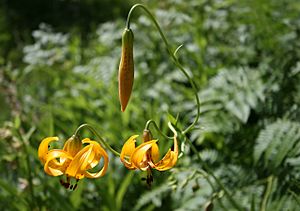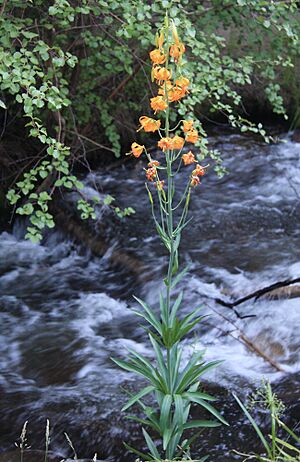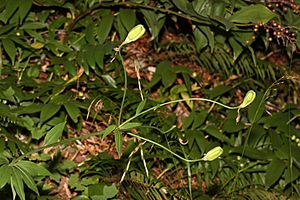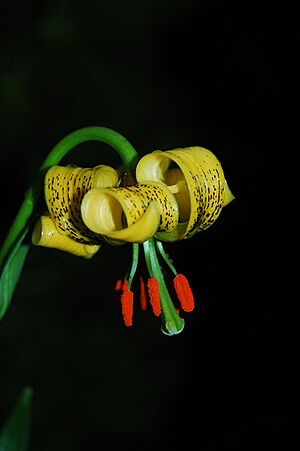Columbia lily facts for kids
The Columbia lily (also called Lilium columbianum) is a beautiful flower. It is a type of lily that grows naturally in western North America. People sometimes call it the Columbia tiger lily or just tiger lily. But remember, other lilies are also called "tiger lily"!
Quick facts for kids Columbia lily |
|
|---|---|
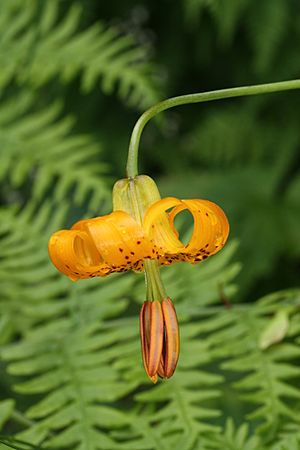 |
|
| Mount Baker-Snoqualmie National Forest | |
| Scientific classification | |
| Genus: |
Lilium
|
| Species: |
columbianum
|
| Synonyms | |
|
Synonymy
Lilium canadense var. minus Alph.Wood
Lilium canadense var. walkeri Alph.Wood Lilium californicum Duch. Lilium sayi Nutt. ex Duch. Lilium canadense var. californicum (Duch.) Bol. Lilium parviflorum (Hook.) W.G.Sm. Lilium lucidum Kellogg Lilium nitidum W.Bull ex Baker Lilium bakeri Purdy Lilium purdyi Waugh |
|
Contents
Where Does the Columbia Lily Grow?
The Columbia lily likes to grow in open areas. You can find it in forests and meadows. It grows from southern British Columbia in Canada all the way south to northern California. It also spreads east to Montana in the northwestern United States.
This lily usually grows below 2,000 m (6,600 ft) (about 6,500 feet). It typically blooms, or flowers, from June through early August. Some small groups of these lilies can be found high up in the Sierra Nevada mountains. They grow as far south as Fresno County, California.
What Does the Columbia Lily Look Like?
The Columbia lily can grow quite tall. It can reach up to 1.2 metres (3.9 ft) (about 4 feet) high. Its flowers are usually orange with darker spots. There can be just a few flowers or many on one plant.
The petals, called tepals, are about 3 to 6 centimeters (1 to 2.5 inches) long. The flowers have a light, pleasant smell. Like many true lilies, its leaves grow in circles around the stem. These circles are called whorls.
How People Use the Columbia Lily
Lily Bulbs as Food
Some Native American groups used the bulbs of the Columbia lily for food. These groups include the Coast Salish and Nuu-chah-nulth peoples. Many western Washington peoples also used them.
They would steam, boil, or cook the bulbs in a pit. The bulbs often tasted a bit bitter or peppery. Because of this, they were mostly used to add flavor. They were often put into soups with meat or fish.
Growing Columbia Lilies in Gardens
If you plant a Columbia lily from a seed, it takes a while to grow. It needs about three to five years to become a full-grown plant.
However, there are faster ways to grow them. You can divide the bulbs that are already growing. Or, you can use small pieces of the bulb, called scales. These methods help new plants grow more quickly.
Images for kids
See also
 In Spanish: Lilium columbianum para niños
In Spanish: Lilium columbianum para niños


